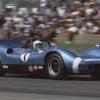
Le Mans oddity
#1

Posted 27 December 2010 - 21:55
This is when the cars were numbered by engine capacity, largest=lowest number down to smallest=highest.
Anyone?
Advertisement
#2

Posted 27 December 2010 - 22:21
Glancing at the DNAs in Wimpffen, there was a Serenissima entry for another birdcage for Scarlatti/Abate that was scheduled to have number 18, but as that number went to the Moss/Hill Aston, I'm betting that the Scarlatti/Abate car would have worn the 8 (some numbers changed from the test day to the race). So presumably Volpi just kept the number he had been allocated.
#3

Posted 27 December 2010 - 23:41
#4

Posted 28 December 2010 - 11:38
The Moss/Hill Ferrari, of course.It's a Serenissima entry, and they also had a Maserati birdcage entered with number 9. Which, as a 3-litre car, fits the numbering bill.
Glancing at the DNAs in Wimpffen, there was a Serenissima entry for another birdcage for Scarlatti/Abate that was scheduled to have number 18, but as that number went to the Moss/Hill Aston, I'm betting that the Scarlatti/Abate car would have worn the 8 (some numbers changed from the test day to the race). So presumably Volpi just kept the number he had been allocated.
The Autosport preview, the week before the race, showed number 8 as a Maserati. The race report merely said that it wasn't explained why a small car had number 8.
#5

Posted 28 December 2010 - 13:17
#6

Posted 28 December 2010 - 14:27
#7

Posted 28 December 2010 - 20:19
Briggs Cunningham received race numbers 6 and 7, but his V12 Maserati engines were experimental. Number 6 measured 2,989 cc, Number 7 measured 2,984 cc.
Count Volpi planned to enter two V12 Maseratis and received numbers 8 and 9. One of them was not finished in time after running at the Nurburgring two weeks earlier. As a result, Volpi replaced his number 8 Maserati entry with a 701 cc Abarth. Volpi's number 9 Maserati V12 had an experimental engine as well and turned out to be 2,990 cc. Based on the Le Mans convention it was placed ahead of the Cunningham cars on the starting grid, with the Abarth towards the end of the line-up.
Since the Aston Martins had larger 3,670 cc [the DB4GTs] and 2,993 cc [the DBR1s] engine capacities, they headed the grid. The Ferrari engines [2,961 cc for number 10, and 2,953cc for the rest] were smaller than the Maseratis and were lined up behind them.
all research: Willem Oosthoek












